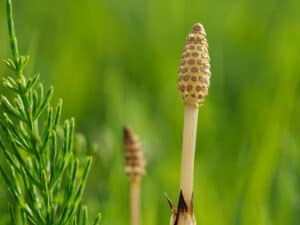What is the Nuisance Weed Horsetail?
Horsetail, also known as Equisetum arvense, is an invasive weed that can grow in many environments, including gardens, lawns, and fields. This deep-rooted perennial weed is known for its distinctive, hollow stems and needle-like leaves. While it may look harmless, horsetail can quickly take over an area and crowd out other plants in a garden and waste ground. In this article, we will explore the characteristics of horsetail and discuss various methods for controlling and preventing its growth.
What are its characteristics?
Horsetail spreads quickly and takes over large areas, making it difficult to control. This native species is perennial, can grow up to 3 feet tall, and has hollow, jointed stems with tiny, scale-like leaves. Its unique appearance and rapid growth make it a tough weed to eliminate.
Not to be confused with Mare’s tail
Many people confuse Horsetail weed for Mare’s tail and vice versa, assuming they are similar, but this couldn’t be further from the truth. While there is some uncanny resemblance between the two, Mare’s tail is an aquatic plant that rarely causes the problems presented by Field horsetail, though it can also spread and block tiny water courses.
How does Horsetail reproduce?
Horsetail reproduces through underground rhizomes- horizontal underground stems that can produce new shoots and roots. These rhizomes can spread out and form new plants, allowing horsetail to colonize an area quickly. The plant can also reproduce through spores produced in large numbers on the top of the stem. These spores can be spread by wind or water and can germinate to form new plants. This usually happens in April, and the stem dies after dispersing the spores; these will germinate approximately two weeks after landing on the ground.
Why should it worry you?
Horsetail is an invasive weed that can cause severe problems by overwhelming your garden or spreading over your patio. It is aggressive enough to push through cracks in the concrete, meaning your patio or driveways aren’t spared. The weed is annoyingly resistant to herbicides, and weeding it manually often will only exacerbate the problem.
Most species of the weed are also poisonous when ingested by livestock, including horses ironically. Horsetail carries dangerous alkaloids and Thiaminase, an enzyme that destroys Vitamin B1, resulting in its deficiency for the animal. While livestock generally lacks a taste for the weed, the impact will be significant if reasonable amounts were to be mixed up in hay and accidentally grazed by the animal as it hampers the production of Vitamin B1.
How do you control Horsetail?
Draining wet areas around your garden, chopping off vegetative horsetail roots and shoots, and applying lime are all viable control methods you may adopt. However, cutting the weed will take forever as there will be too many rhizomes to stop it from spreading. Mechanical cultivation will only compound the infestation since new plants grow from the tiniest pieces of rhizomes. Here are some of the methods that industry experts use to deal with and manage Horsetail:
Cultural Control
Getting rid of Horsetail by hand is often a hopeless endeavour, especially considering how deep into the soil the roots grow. However, you might have some success removing the shoots soon after emerging above ground, as this can slow down the infestation when performed consistently over a couple of years. You can use a lawn mower to do this every time you notice a weed on your lawn. The Wildlife and Countryside Act supports this method.

Chemical Control
The thick layering of wax on the Horsetail cuticles makes it difficult to penetrate the weed with herbicides. The branches are also tiny and needle-like, leaving you with minimal exposed area to spray on. Apart from the physical barrier, the weed has large storage organs hidden underground that are tough to reach. These factors make Equisetum arvense a resistant weed.
If you can’t use an alternative residual weed to control the Horsetail infestation or don’t plan to replant in the area, the best way to control it is to use an industry Weed expert who will use environmentally acceptable, non-residual herbicide as follows.
Foliar Spraying
They will wait for the vegetative roots of the plant to achieve their maximum height and open. This usually happens in July. The stems are bruised before applying the herbicide by spraying to compromise the wax layers and enable easy penetration.
Weed Wiping
This is another method used to apply the herbicide to inhibit the growth of new shoots. In areas where the Horsetail is encroaching, a weed-wiping glove or rake is used to bruise the weed before applying the herbicide.
You should note that Horsetail is a persistent weed, so continuous application over several months or even years may be the only way of permanently eradicating the nuisance.
Stem Injection
If the infestation is in such a way that makes it impractical to spray, your weed expert may suggest stem injection. This is also an excellent option for weed remnants after the initial spray treatment. The only downside is that it is labour-intensive.
The herbicide is injected into the weed’s stems which is again very labour-intensive. The stems are then removed and disposed of especially in areas where livestock graze.
Horsetail Weed Summary
Understanding the characteristics of horsetail and taking a comprehensive approach to controlling and preventing its growth is key to keeping this weed at bay. Whether you’re a gardener, farmer, or homeowner, it’s important to stay vigilant and take action to keep horsetail from spreading. With the right approach and persistence, an industry weed professional can successfully manage this nuisance weed and maintain a healthy, thriving landscape at your home or business.
Contact Green Leaf Remediation & Garden Services today at 01269 591651 to arrange your free and no-obligation site survey.

Martyn works for Green Leaf Remediation as a marketing specialist. He takes great pride in creating quality content regarding Japanese knotweed.
